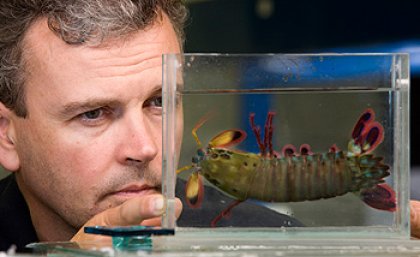
The remarkable eyes of a marine crustacean could inspire the next generation of DVD and players, according to new research from The University of Queensland published today in Nature Photonics (DOI: 10.1038/nphoton.2009.189).
Professor Justin Marshall, from UQ’s School of Biomedical Sciences and the Queensland Brain Institute, said mantis shrimps have the most complex vision systems known to science, far above what humans have been able to come up with.
He said this discovery has revealed these animals see circular polarized light and the way in which this is done has exciting potential for man-made optical devices.
“They can see in 12 colours, while humans can only see in three, and the shrimps can also distinguish between different forms of polarized light,” Professor Marshall said.
“Artificial devices such as DVD players only tend to work well for one colour of light, while the natural mechanism in the mantis shrimp’s eyes works almost perfectly across the whole visible spectrum, from near-ultra violet to infra-red.
“Exactly why the mantis shrimp needs such exquisite sensitivity to circularly polarized light isn’t clear.
“However, polarization vision is used by animals for sexual signalling or secret communication that avoids the attention of other marine animals, especially predators.
“It could also assist in the finding and catching of prey by improving the clarity of images underwater.”
Working with colleagues from UQ, the University of Bristol, and the University of Maryland, Professor Marshall said the work revealed for the first time the unique design and mechanism of the quarter-wave plate in the mantis shrimp’s eye.
“What’s particularly exciting is how beautifully simple it is,” he said.
“This natural mechanism, comprised of cell membranes rolled into tubes, completely outperforms synthetic designs.
“It could help us make better optical devices in the future using liquid crystals that have been chemically engineered to mimic the properties of the cells in the shrimp’s eye.“
He said this wouldn’t be the first time humans have looked to the natural world for new ideas, for example the lobster’s compound eye recently inspired the design of an X-ray detector for an astronomical telescope.
Media: Professor Justin Marshall (07 3365 1397, 0423 024 162) or Andrew Dunne at UQ Communications (07 3365 2802, 0433 364 181).
.jpg)


